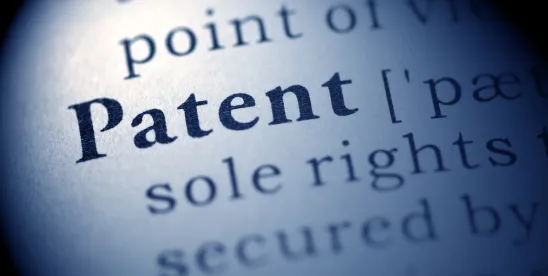Celanese International Corporation, Celanese (Malta) Company 2 Limited, and Celanese Sales U.S. Ltd. (collectively, “Celanese”) filed a petition before the United States International Trade Commission (the “ITC”), alleging that Anhui Jinhe Industrial Co., Ltd., Jinhe USA LLC (collectively “Jinhe”) and other entities violated 19 U.S.C. § 337.[1] Celanese alleged that Jinhe and other entities were importing Ace-K (an artificial sweetener) made using a process that infringed Celanese’s patents. Each of the patents asserted by Celanese had an effective filing date of September 21, 2016, and as a result are governed by the America Invents Act (“AIA”).
It was undisputed that Celanese’s patented process was in secret use in Europe before the critical date of September 21, 2015, i.e., one year before the effective filing date of the asserted patents. Also undisputed was the fact that Celanese had sold Ace-K made using the patented process in the United States before the critical date.
As a result, Jinhe moved for a summary determination of no violation of 19 U.S.C. § 337 on the grounds that the claims at issue were invalid under the on-sale bar provision of 35 U.S.C. § 102(a)(1). Celanese did not dispute that under pre-AIA precedent, sales of products made using a secret process triggered the on-sale bar, and precluded the patentability of the process. Instead, Celanese’s argument in response was that the AIA changed the pre-AIA law such that the pre-critical date sales of Ace-K made using its secret process would not trigger the on-sale bar.
The presiding Administrative Law Judge (“ALJ”) rejected Celanese’s argument, concluding that the prior sales triggered the on-sale bar and that the AIA did not overturn settled pre-AIA precedent. In rejecting Celanese’s argument, the ALJ relied primarily on the Supreme Court’s decision in Helsinn Healthcare S.A. v. Teva Pharms. USA, Inc. 586 U.S. 123 (2019). More specifically, the ALJ rejected each of Celanese’s three main arguments: (1) the textual changes between the statutes overturned the settled pre-AIA law; (2) the AIA’s removal of pre-AIA Section 102(g) and the expansion of prior-user rights under Section 273 overturned the settled pre-AIA law; and (3) the legislative history showed Congress’s intent to overturn the settled pre-AIA law.
Celanese petitioned the ITC for review of the ALJ’s decision. The ITC denied Celanese’s petition, making the ALJ’s decision final. Celanese appealed to the Court of Appeals for the Federal Circuit.
Issue
Whether the AIA changed Section 102’s on-sale bar such that sales of a product made using a secret process prior to the critical date would not invalidate later-sought claims on the process?
Holding
No, the AIA did not change the settled pre-AIA law regarding sales of a product using a secret process for purposes of the on-sale bar, making Celanese’s pre-critical date sales invalidating prior art for its asserted patents.
Reasoning
As an initial matter the Federal Circuit discussed the history of the “on-sale” bar, highlighting its purpose of preventing one from “extending a patent monopoly beyond the statutory term by commercially exploiting an invention prior to seeking a patent.” Celanese Int’l Corp. v. Int’l Trade Comm’n, 2022-1827, at 7. The “on-sale” provision, a part of U.S. patent law since the first Patent Act in 1836, established that pre-critical date sales of products made using a secret process would bar patentability and render invalid later sought patent claims on that process. Additionally, both the Federal Circuit and subsequently the Supreme Court in Helsinn held that “Congress reenacted the ‘on-sale’ language ‘against the backdrop of a substantial body of law interpreting § 102’s on-sale bar.’” Id. at 9. (quoting Helsinn, 586 U.S. at 130.) In other words, there is a presumption that Congress meant to attach the same meaning from settled pre-AIA law of “on sale” to the AIA. Id. at 9-10. It was within this context the Federal Circuit determined whether Congress intended to abrogate settled construction of the term “on sale.”
The Federal Circuit focused on Celanese’s three main sources of support for why Congress intended to alter the on-sale bar such that the pre-critical date sales of Ace-K would not invalidate its later-sought patent claims: (1) textual changes in Section 102; (2) other AIA sections; and (3) selected excerpts from the legislative history.
The textual changes Celanese pointed to are AIA Section 102(a)’s (i) replacement of “invention’ with “claimed invention,” and (ii) addition of the catchall phrase “otherwise available to the public.” Id. at 10. Under the AIA, Celanese argued, sales of a product made using a claimed process invention, that does not publicly disclose the process, would no longer trigger the on-sale bar. The Federal Circuit, however, found that neither of these changes supported the foundational change of the on-sale provision Celanese argued for.
Starting with the replacement of “invention” with “claimed invention,” the Federal Circuit pointed out that the statutory language “references the same ‘invention’ that applicant seeks to patent, and nothing else.” Id. at 11. According to the Federal Circuit, the fact that Congress chose to use “claimed invention” instead of “invention” in the AIA “reflects nothing more than a clerical refinement of terminology for the same meaning in substance.” Id. at 11.
Turning next to the catchall phrase “or otherwise available to the public” the Federal Circuit noted that the Supreme Court already considered and rejected this argument in Helsinn. Id. at 12. In Helsinn, the Supreme Court found that the “on sale” category “never required that a qualifying commercial sale reveal to the public the details of the claimed invention.” Id. at 12. Furthermore, the addition of the catchall phrase “otherwise available to the public” was added to capture the material or activities that do not fit neatly within the statutes enumerated categories, but that were nevertheless, intended to be covered. Id. The Federal Circuit found no support in these textual changes that would support Celanese’s proposition that Congress intended to alter the on-sale bar as it applies to process inventions, or to “disturb the underlying rationale in case law.” Id. at 12.
Next, the Federal Circuit addressed Celanese’s argument that other provisions of the AIA, including Sections 102(b), 271(g), and 273(a), show that Congress intended to alter the scope of the on-sale bar.
With regard to Section 102(b), Celanese argued that since 102(b)(1) provides a one-year grace period for “disclosures” made “by the inventor,” no grace period would exist for any “secret commercialization” that did not disclose the details of the invention. Id. at 13. In other words, Celanese argued that there would be a mismatch between Section 102(a)’s on-sale provision and Section 102(b)(1)’s grace period. Id. The Federal Circuit rejected this argument relying primarily on its previous rationale for the textual changes, namely that the on-sale bar does not require that the claimed invention must have been disclosed to someone. Moreover, the Federal Circuit did not believe it was necessary to construe the terms in Section 102(b)(1) and refused to do so, because the grace period is not triggered (since the sales in question were outside the one-year grace period).
For Section 271(g) (infringement by third-parties) Celanese argued that the section’s reference to “a product made by a process” that does not appear in Section 102(a)’s on-sale provision is further evidence of Congress’s intention that Section 102(a)’s on-sale bar no longer encompass sale of products made via a secret process. Additionally, Celanese argued that if Section 102(a)’s on-sale bar were to apply to sales of products made using a secret process, it would render Section 273(a)’s prior usage defense superfluous.
The Federal Circuit noted that Section 273 is concerned with patent infringement, while Section 102(a) is concerned with patent validity, which are legally distinct issues. The Federal Circuit failed to see how statutory provisions concerning infringement would govern the interpretation of 102(a)’s on-sale bar.
Lastly, the Federal Circuit addressed Celanese’s argument that the AIA’s legislative history indicates that Congress intended to remove sales similar to Celanese’s pre-critical date sales from the scope of the on-sale bar. The main support for this argument came in the form of a colloquy between two senators, in which Senator Leahy stated that “subsection 102(a) was drafted in part to do away with [the] precedent . . . that private offers for sale or private uses or secret processes practiced in the United States . . . may be deemed patent-defeating prior art.” Id. at 16 (citations omitted). Celanese argued that Sen. Leahy’s statement showed a clear intent of Congress to alter pre-AIA law by requiring that triggering sales under Section 102(a) must disclose details of the invention to the public.
The Federal Circuit made it a point to caution that the views of individual legislators do not necessarily establish the legislative intent of Congress as a whole, pointing to both Federal Circuit and Supreme Court precedent. Moreover, the Federal Circuit pointed out that the same colloquy was relied on by Helsinn at both the Federal Circuit and the Supreme Court. Both times the Federal Circuit and later the Supreme Court rejected Helsinn’s reliance on Sen. Leahy’s colloquy. Specifically, the Federal Circuit determined then, that Sen. Leahy’s statement when viewed in context, was concerned with at most “public use,” and did not support a foundational change to the theory of the statutory on-sale bar found in Section 102(a). The Federal Circuit also noted that Supreme Court in Helsinn held that a sale does not need to “make the details of the invention available to the public” to trigger the on-sale bar under Section 102(a). Id. at 17.
Conclusion
Having considered and rejected all of Celanese’s arguments, the Federal Circuit affirmed the International Trade Commission’s ruling that the AIA did not abrogate settled pre-AIA law regarding the on-sale bar provision of Section 102(a) and Celanese’s pre-critical date sales of Ace-K triggered the on-sale bar.
FOOTNOTES
[1] Celanese International Corporation v. ITC, No. 2022-1827 (Fed. Cir. 2024)



 />i
/>i
